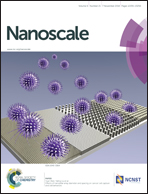Cytotoxicity of nucleus-targeting fluorescent gold nanoclusters†
Abstract
Gold nanoclusters (AuNCs) with ultra small sizes and unique fluorescence properties have shown promising potential for imaging the nuclei of living cells. However, little is known regarding the potential cytotoxicity of AuNCs after they enter the cell nucleus. The aim of this study is to investigate whether and how nucleus-targeting AuNCs affect the normal functioning of cells. Highly stable, water-soluble and bright fluorescent Au25NCs (the core of each nanocluster is composed of 25 gold atoms) were synthesized. Specific targeting of Au25NCs to the cell nucleus was achieved by conjugating the TAT peptide to the Au25NCs. Cell viability, cell morphology, cell apoptosis/necrosis, reactive oxygen species (ROS) level and mitochondrial membrane potential examinations were performed on different cell lines exposed to the nucleus-targeting Au25NCs. We found that the nucleus-targeting Au25NCs caused cell apoptosis in a dose-dependent manner. A possible mechanism for the cytotoxicity of the nucleus-targeting Au25NCs was proposed as follows: the nucleus-targeting Au25NCs induce the production of ROS, resulting in the oxidative degradation of mitochondrial components, in turn leading to apoptosis via a mitochondrial damage pathway. This work facilitates a better understanding of the toxicity of AuNCs, especially nucleus-targeting AuNCs.


 Please wait while we load your content...
Please wait while we load your content...